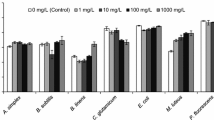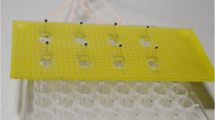Abstract
The effect of growth rate, growth phase, pH, and temperature on the permanent adhesion of a glidingFlexibacter sp. and three nongliding bacteria,Pseudomonas fluorescens, Enterobacter cloacae, andChromobacterium sp., to polystyrene substrata was investigated. The permanent adhesion of the flexibacter appeared to be related to growth, as levels of adhesion increased with increased growth rate in continuous culture and declined rapidly with death phase in batch culture. With the three nongliding bacteria, there was no relationship between growth rate and levels of permanent adhesion. The permanent adhesion of the nongliding bacteria was maximum between pH 5.5 and pH 7 and between 20 and 30°C, whereas the adhesion of the flexibacter progressively decreased with increasing temperature and pH. The effect of different nutrient conditions on the gliding motility of the flexibacter across agar was also investigated. Gliding motility was inhibited by increased nutrient concentration and was affected by carbon source. Inhibition appeared to be related to the accumulation of a viscous exopolymer. It is proposed that the differences in the permanent adhesion of the gliding and nongliding bacteria may be related to their adaptation to different ecological niches.
Similar content being viewed by others
References
Boyle CD, Reade AE (1983) Characterization of two extracellular polysaccharides from marine bacteria. Appl Environ Microbiol 46:392–399
Burchard RP (1981) Gliding motility of prokaryotes: ultrastructure, physiology and genetics. Ann Rev Microbiol 35:497–529
Daniels SC (1980) Mechanisms involved in Sorption of microorganisms to solid surfaces. In:Bitton G, Marshall KC (eds) Adsorption of microorganisms to surfaces. John Wiley and Sons, New York, pp 8–58
Duxbury T, Humphrey BA, Marshall KC (1980) Continuous observations of bacterial gliding motility in dialysis microchamber: the effects of inhibitors. Arch Microbiol 124:169–175
Feldner J, Bredt W, Kahane I (1983) Influence of cell shape and surface charge on attachment ofMycoplasma pneumoniae to glass surfaces. J Bacteriol 153:1–5
Fletcher M (1976) The effects of proteins on bacterial attachment to polystyrene. J Gen Microbiol 94:400–404
Fletcher M (1977) The effects of culture concentration and age, time and temperature on bacterial attachment to polystyrene. Can J Microbiol 23:1–6
Fletcher M (1980) The question of passive versus active attachment mechanisms in nonspecific bacterial adhesion. In: Berkeley RCW, Lynch JM, Melling J, Rutter PR, Vincent B (eds) Microbial adhesion to surfaces. Ellis Horwood, Chichester, UK, pp 197–210
Henrichsen J (1972) Bacterial surface translocation: a survey and a classification. Bacteriol Rev 36:478–503
Hogt AH, Feijen J, Dankert J, de Vries JA (1982) Adhesion ofStaphylococcus epidermidis andStaphylococcus saprophyticus onto FEP-teflon and cellulose acetate. In: Biomedical polymers: proc Biological Engineering Soc. Biological Engineering Society, London, pp 39–47
Hugh R, Leifson E (1953) The taxonomic significance of fermentative versus oxidative metabolism of carbohydrate by various gram-negative bacteria. J Bacteriol 66:24–26
Humphrey BA, Dickson MR, Marshall KC (1979) Physicochemical and in situ observations on the adhesion of gliding bacteria to surfaces. Arch Microbiol 120:231–238
Knox KW, Hardy LN, Wicken AJ (1986) Comparative studies on the protein profiles and hydrophobicity of strains ofStreptococcus mutans serotypec. J Gen Microbiol 132:2541–2548
Maroudas NG (1973) Chemical and mechanical requirements of fibroblast adhesion. Nature (London) 244:353–354
Marshall KC (1967) Electrophoretic properties of fast and slow growing species ofRhizobium- Aust J Biol Sci 20:429–438
Marshall KC (1985) Mechanisms of bacterial adhesion at solid-water interfaces. In: Savage DC, Fletcher M (eds) Bacterial adhesion. Plenum Press, New York, pp 133–161
Marshall KC, Stout R, Mitchell R (1971) Mechanisms of the initial events in the sorption of marine bacteria to surfaces. J Gen Microbiol 68:337–348
McEldowney S, Fletcher M (1986) The effect of growth conditions and surface characteristics of aquatic bacteria on their attachment to solid surfaces. J Gen Microbiol 132:513–523
McEldowney S, Fletcher M (1986) Variability of the influence of physicochemical factors affecting bacterial adhesion to polystyrene substrata. Appl Environ Microbiol 52:460–465
Minato H, Suto T (1976) Technique for fractionation of bacteria in rumen microbial ecosystem. I. Attachment of rumen bacteria to starch granules and elution of bacteria attached to them. J Gen Microbiol 22:259–276
Olsson J, Westergren G (1972) Hydrophobic surface properties of oral streptococci. FEMS Microbiol Lett 15:319–323
Pate JL (1985) Gliding motility in cytophaga. Microbiol Sci 2:292–295
Paul JH (1984) Effects of antimetabolites on the adhesion of an estuarineVibrio sp. to polystyrene. Appl Environ Microbiol 48:924–929
Plummer DT, James AM (1961) Some physical investigations of the behaviour of bacterial surfaces. III. The variation of the electrophoretic mobility and capsule size ofAerobacter aerogenes with age. Biochim Biophys Acta 53:453–460
Pourdjabber F, Russell C (1979) Factors affecting adhesion of bacteria to a tooth in vitro. Microbios 26:73–84
Pringle JH, Fletcher M, Ellwood DC (1983) Selection of attachment mutants during continuous culture ofPseudomonas fluorescens and relationship between attachment ability and surface composition. J Gen Microbiol 129:2557–2569
Rudd T, Sterripp RM, Lester JN (1982) The use of extraction methods for the quantification of extracellular polymer production byKlebsiella aerogenes under varying cultural conditions. Eur J Appl Microbiol Biotechnol 16:23–27
Stanier RY (1947) Studies on non-fruiting myxobacteria. I.Cytophaga johnsonae n. sp., a chitin-decomposing myxobacterium. J Bacteriol 53:297–315
Stanley PM (1983) Factors affecting the irreversible attachment ofPseudomonas aeruginosa to stainless steel. Can J Microbiol 29:1493–1499
Stanley SO, Rose AW (1967) On the clumping ofCorynebacterium xenosis as affected by temperature. J Gen Microbiol 48:9–23
Sutherland IW (1983) Microbial exopolysaccharides—their role in microbial adhesion in aqueous systems. CRC Crit Rev Microbiol 10:173–201
Zoltai PT, Zottola EA, McKay LL (1981) Scanning electron microscopy of microbial attachment to milk contact surfaces. J Food Protect 44:204–208
Author information
Authors and Affiliations
Rights and permissions
About this article
Cite this article
McEldowney, S., Fletcher, M. Effect of pH, temperature, and growth conditions on the adhesion of a gliding bacterium and three nongliding bacteria to polystyrene. Microb Ecol 16, 183–195 (1988). https://doi.org/10.1007/BF02018913
Issue Date:
DOI: https://doi.org/10.1007/BF02018913




